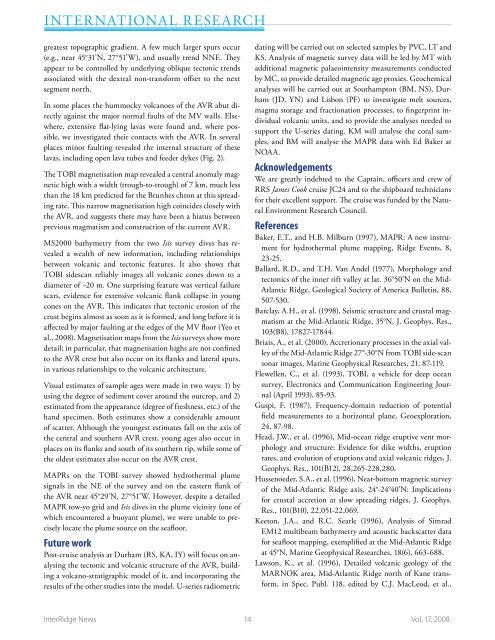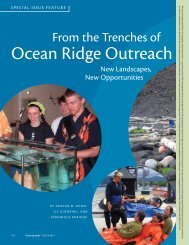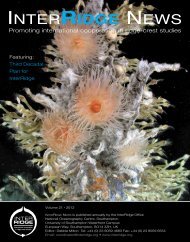Full version, lower resolution, 3.25MB - InterRidge
Full version, lower resolution, 3.25MB - InterRidge
Full version, lower resolution, 3.25MB - InterRidge
You also want an ePaper? Increase the reach of your titles
YUMPU automatically turns print PDFs into web optimized ePapers that Google loves.
International Research<br />
greatest topographic gradient. A few much larger spurs occur<br />
(e.g., near 45°31’N, 27°51’W), and usually trend NNE. They<br />
appear to be controlled by underlying oblique tectonic trends<br />
associated with the dextral non-transform offset to the next<br />
segment north.<br />
In some places the hummocky volcanoes of the AVR abut directly<br />
against the major normal faults of the MV walls. Elsewhere,<br />
extensive flat-lying lavas were found and, where possible,<br />
we investigated their contacts with the AVR. In several<br />
places minor faulting revealed the internal structure of these<br />
lavas, including open lava tubes and feeder dykes (Fig. 2).<br />
The TOBI magnetisation map revealed a central anomaly magnetic<br />
high with a width (trough-to-trough) of 7 km, much less<br />
than the 18 km predicted for the Brunhes chron at this spreading<br />
rate. This narrow magnetisation high coincides closely with<br />
the AVR, and suggests there may have been a hiatus between<br />
previous magmatism and construction of the current AVR.<br />
MS2000 bathymetry from the two Isis survey dives has revealed<br />
a wealth of new information, including relationships<br />
between volcanic and tectonic features. It also shows that<br />
TOBI sidescan reliably images all volcanic cones down to a<br />
diameter of ~20 m. One surprising feature was vertical failure<br />
scars, evidence for extensive volcanic flank collapse in young<br />
cones on the AVR. This indicates that tectonic erosion of the<br />
crust begins almost as soon as it is formed, and long before it is<br />
affected by major faulting at the edges of the MV floor (Yeo et<br />
al., 2008). Magnetisation maps from the Isis surveys show more<br />
detail; in particular, that magnetisation highs are not confined<br />
to the AVR crest but also occur on its flanks and lateral spurs,<br />
in various relationships to the volcanic architecture.<br />
Visual estimates of sample ages were made in two ways: 1) by<br />
using the degree of sediment cover around the outcrop, and 2)<br />
estimated from the appearance (degree of freshness, etc.) of the<br />
hand specimen. Both estimates show a considerable amount<br />
of scatter. Although the youngest estimates fall on the axis of<br />
the central and southern AVR crest, young ages also occur in<br />
places on its flanks and south of its southern tip, while some of<br />
the oldest estimates also occur on the AVR crest.<br />
MAPRs on the TOBI survey showed hydrothermal plume<br />
signals in the NE of the survey and on the eastern flank of<br />
the AVR near 45°29’N, 27°51’W. However, despite a detailed<br />
MAPR tow-yo grid and Isis dives in the plume vicinity (one of<br />
which encountered a buoyant plume), we were unable to precisely<br />
locate the plume source on the seafloor.<br />
Future work<br />
Post-cruise analysis at Durham (RS, KA, IY) will focus on analysing<br />
the tectonic and volcanic structure of the AVR, building<br />
a volcano-stratigraphic model of it, and incorporating the<br />
results of the other studies into the model. U-series radiometric<br />
dating will be carried out on selected samples by PVC, LT and<br />
KS. Analysis of magnetic survey data will be led by MT with<br />
additional magnetic palaeointensity measurements conducted<br />
by MC, to provide detailed magnetic age proxies. Geochemical<br />
analyses will be carried out at Southampton (BM, NS), Durham<br />
(JD, YN) and Lisbon (PF) to investigate melt sources,<br />
magma storage and fractionation processes, to fingerprint individual<br />
volcanic units, and to provide the analyses needed to<br />
support the U-series dating. KM will analyse the coral samples,<br />
and BM will analyse the MAPR data with Ed Baker at<br />
NOAA.<br />
Acknowledgements<br />
We are greatly indebted to the Captain, officers and crew of<br />
RRS James Cook cruise JC24 and to the shipboard technicians<br />
for their excellent support. The cruise was funded by the Natural<br />
Environment Research Council.<br />
References<br />
Baker, E.T., and H.B. Milburn (1997), MAPR: A new instrument<br />
for hydrothermal plume mapping, Ridge Events, 8,<br />
23-25.<br />
Ballard, R.D., and T.H. Van Andel (1977), Morphology and<br />
tectonics of the inner rift valley at lat. 36°50'N on the Mid-<br />
Atlantic Ridge, Geological Society of America Bulletin, 88,<br />
507-530.<br />
Barclay, A.H., et al. (1998), Seismic structure and crustal magmatism<br />
at the Mid-Atlantic Ridge, 35°N, J. Geophys. Res.,<br />
103(B8), 17827-17844.<br />
Briais, A., et al. (2000), Accretionary processes in the axial valley<br />
of the Mid-Atlantic Ridge 27°-30°N from TOBI side-scan<br />
sonar images, Marine Geophysical Researches, 21, 87-119.<br />
Flewellen, C., et al. (1993), TOBI, a vehicle for deep ocean<br />
survey, Electronics and Communication Engineering Journal<br />
(April 1993), 85-93.<br />
Guspi, F. (1987), Frequency-domain reduction of potential<br />
field measurements to a horizontal plane, Geoexploration,<br />
24, 87-98.<br />
Head, J.W., et al. (1996), Mid-ocean ridge eruptive vent morphology<br />
and structure: Evidence for dike widths, eruption<br />
rates, and evolution of eruptions and axial volcanic ridges, J.<br />
Geophys. Res., 101(B12), 28,265-228,280.<br />
Hussenoeder, S.A., et al. (1996), Near-bottom magnetic survey<br />
of the Mid-Atlantic Ridge axis, 24°-24°40'N: Implications<br />
for crustal accretion at slow spreading ridges, J. Geophys.<br />
Res., 101(B10), 22,051-22,069.<br />
Keeton, J.A., and R.C. Searle (1996), Analysis of Simrad<br />
EM12 multibeam bathymetry and acoustic backscatter data<br />
for seafloor mapping, exemplified at the Mid-Atlantic Ridge<br />
at 45°N, Marine Geophysical Researches, 18(6), 663-688.<br />
Lawson, K., et al. (1996), Detailed volcanic geology of the<br />
MARNOK area, Mid-Atlantic Ridge north of Kane transform,<br />
in Spec. Publ. 118, edited by C.J. MacLeod, et al.,<br />
<strong>InterRidge</strong> News 14 Vol. 17, 2008
















